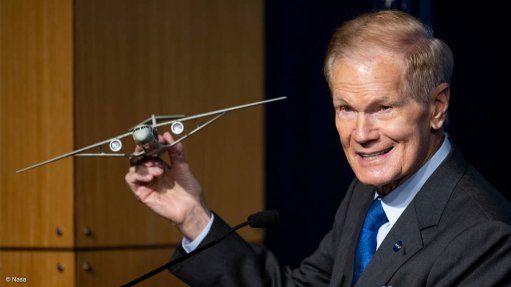
Nasa administrator Bill Nelson holds a model of the SFD TTBW test aircraft
Photo by: Nasa
The US National Aeronautics and Space Administration (Nasa) on Wednesday awarded US major aerospace group Boeing a commercial aviation technology development contract, under which the manufacturer will build a full-scale demonstrator aircraft to test and evaluate technologies to reduce fuel expenditure and so also greenhouse-gas emissions. Although globally most famous for its space research, Nasa, as its full name signals, is also one of the world’s top aeronautical research agencies.
Nasa will invest $425-million in the project, with Boeing and its partners contributing up to $725-million more. The project, designated the Sustainable Flight Demonstrator (SFD) programme, seeks to build and fly a single-aisle airliner-sized aircraft to test concepts that could reduce fuel consumption and carbon emissions by up to 30%, in comparison to today’s most efficient such airliners. The aim is that the test programme would be completed by late 2020s. This would allow its results to be fed into the design of the next-generation of single-aisle airliners, expected to enter service in the 2030s.
“Since the beginning, Nasa has been with you when you fly,” highlighted Nasa administrator Bill Nelson. “Nasa has dared to go farther, faster, higher. And in doing so, Nasa has made aviation more sustainable and dependable. It is in our DNA. It’s our goal that Nasa’s partnership with Boeing to produce and test a full-scale demonstrator will help lead to future commercial airliners that are more fuel efficient, with benefits to the environment, the commercial aviation industry and to passengers worldwide. If we are successful, we may see these technologies in planes that the public takes to the skies in the 2030s.”
“The SFD programme has the potential to make a major contribution toward a sustainable future,” pointed out Boeing chief engineer and Engineering, Test and Technology executive VP Greg Hyslop. “It represents an opportunity to design, build and fly a full-scale experimental plane, while solving novel technical problems.”
The planned SFD aircraft will have a configuration called Transonic Truss-Braced Wing (TTBW). This means that it will have high-mounted, particularly long and thin wings, stabilised by diagonal struts anchored on its lower fuselage. In some ways, it will look remarkably old-fashioned. Boeing will construct the aircraft using a mixture of components from its existing production types and totally-new components, integrated together.
Any future production TTBW-type airliners would also benefit from advances in materials and propulsion systems technologies as well as in systems architectures. Having high wings will also allow them to carry larger engines than current low-wing single-aisle airliner designs. Larger diameter turbofan engines are more fuel efficient than smaller diameter ones.